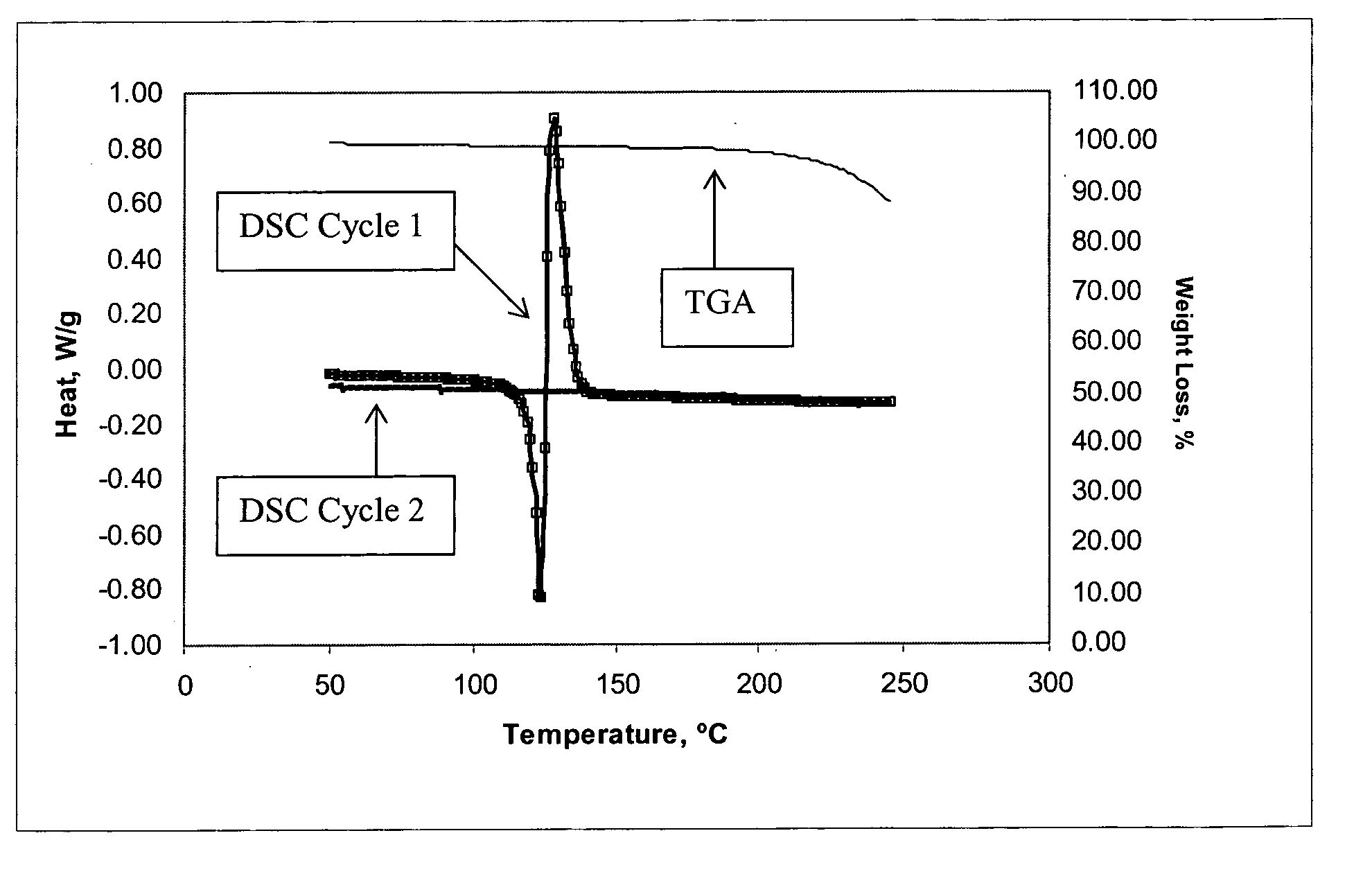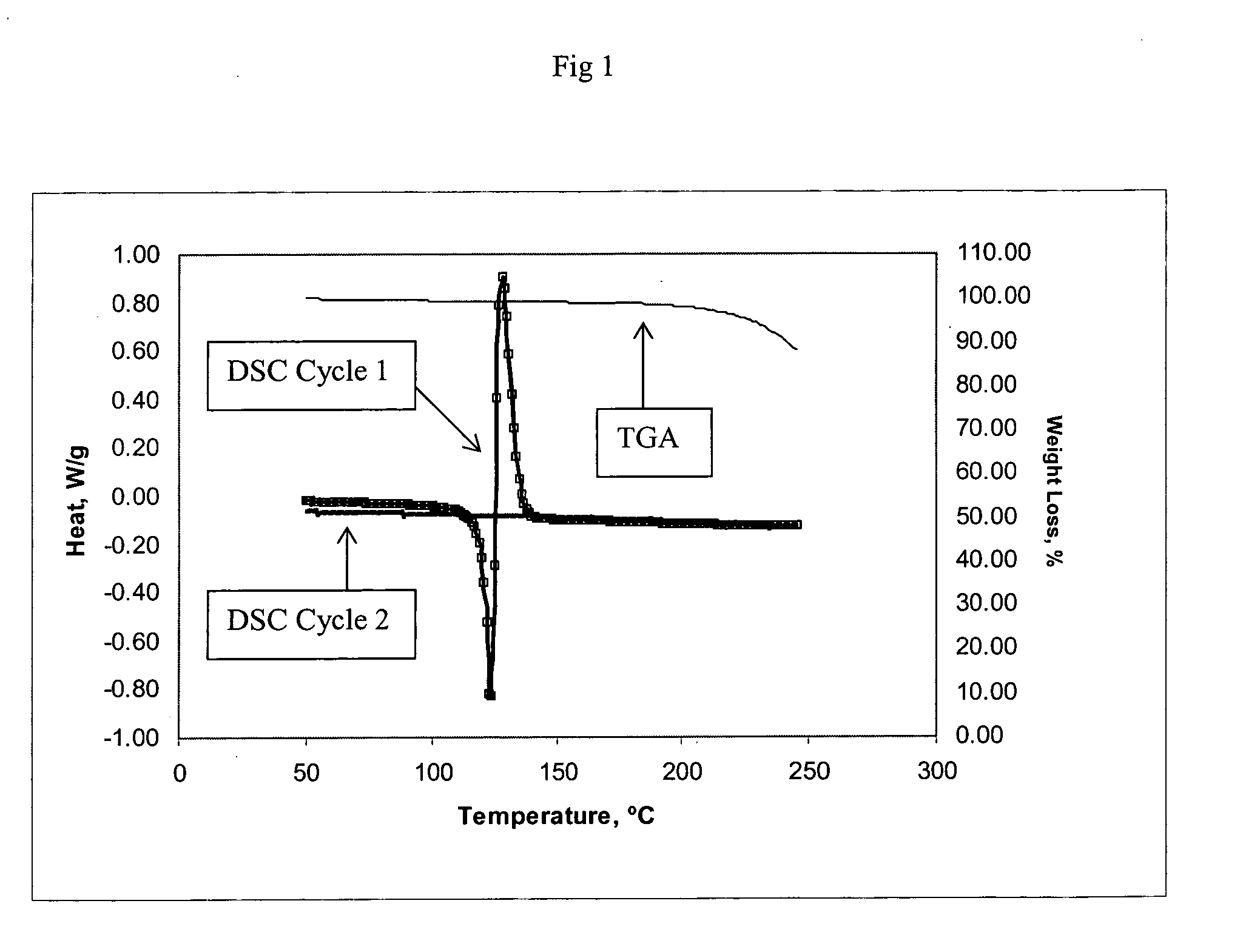Method of producing a crosslinked coating in the manufacture of integrated circuits
a crosslinked coating and integrated circuit technology, applied in the direction of optics, basic electric elements, electric apparatus, etc., can solve the problems of reducing resolution, insensitive to the wavelengths in the deep uv region, and insufficient absorption of resist compositions used at the higher wavelengths of 436 nm and 365 nm
- Summary
- Abstract
- Description
- Claims
- Application Information
AI Technical Summary
Benefits of technology
Problems solved by technology
Method used
Image
Examples
example 1a
N-(4-METHOXYBENZYL)-N,N-DIMETHYLANILINIUM TRIFLUOROMETHANESULFONATE
[0142] 100 g (0.3493 mol) of N-(4-methoxybenzyl)-N,N-dimethylanilinium chloride and 300 g of water were added to a 4 neck reaction flask. The flask is equipped with a mechanical stirrer, thermocouple probe, a cool water condenser, and a nitrogen sweep. 48.25 g (0.3151 mol) of trifluoromethanesulfonic acid was added to the suspension of anilinum chloride in water over a 1 hour period using a pressure equalizing addition funnel. The temperature was monitored not to exceed 40° C. The N-(4-Methoxybenzyl)-N,N-dimethylanilinium triflate precipitates as the reaction proceeds. When the addition of trifluoromethanesulfonic acid is complete, the reaction mixture was stirred for ½ hour. The N-(4-Methoxybenzyl)-N,N-dimethylanilinium triflate was filtered from the aqueous phase, and the product was washed with an excess of water until the pH of the rinse water ranges from 5-6. The N-(4-Methoxybenzyl)-N,N-dimethylanilinium Trifla...
examples 1b-1f
[0143] Examples 1B-1F were prepared using the general procedure of Example 1A from the appropriate quaternary ammonium chlorides and acids shown in Table 1. The reaction yields, and spectroscopic data are reported in Table 2. In the case of Example 1F the product was a viscous liquid and was isolated by simply separating the insoluble liquid product from the aqueous reaction mixture
TABLE 1Reagent Charges for Synthesis of Examples 1B-1FQuaternary ammoniumSamplechlorideAcidProduct1B 60.0 grams 20.0 gramsN-(benzyl)-N,N-N-(benzyl)-N,N-Trifluoromethanedimethylanilinium triflatedimethylanilinium chloridesulfonic acid1C 26.0 grams 8.7 gramsN-(4-methylbenzyl)-N,N-N-(4-methylbenzyl)-N,N-Trifluoromethanedimethylanilinium triflatedimethylanilinium chloridesulfonic acid1D100.0 grams107.0 gramsN-(benzyl)-N,N-N-(benzyl)-N,N-Trifluoromethanedimethyltoluidinium triflatedimethyltoluidinium chloridesulfonic acid1E 25.0 grams 24.4 gramsN-(4-nitrobenzyl)-N,N-N-(methoxybenzyl)-N,N-Nonafluorobutyldimet...
example 2a
Antireflective Coating from Poly(4-hydroxystyrene), an Amino Crosslinker and the Thermal Acid Generator of Example 1A
[0146] An antireflective coating composition was made by dissolving 7.0 g of poly(4-hydroxystyrene), 2.09 g of tetrakis(methoxymethyl)glycoluril (Powderlink® 1174 available from Cytec Industries, West Paterson, N.J.), 0.8 g of a 12.5 wt % solution of the thermal acid generator of Example 1A in methanol and 27 g of ethyl lactate. The solution was filtered through 0.45 and 0.2 μm filters.
[0147] The antireflective coating formulation was evaluated for both storage stability (shelf life) and cure profile (cure as a function of both time and temperature). The storage stability of the formulation was determined by placing 10 grams in a closed 2 dram glass vial and then visually inspecting for any changes in color or viscosity after standing for 24 hours at room temperature. The formulation was inspected a second time after 1 month. The results are reported in Table 4.
[01...
PUM
| Property | Measurement | Unit |
|---|---|---|
| temperature | aaaaa | aaaaa |
| wavelength | aaaaa | aaaaa |
| wavelengths | aaaaa | aaaaa |
Abstract
Description
Claims
Application Information
 Login to View More
Login to View More - R&D
- Intellectual Property
- Life Sciences
- Materials
- Tech Scout
- Unparalleled Data Quality
- Higher Quality Content
- 60% Fewer Hallucinations
Browse by: Latest US Patents, China's latest patents, Technical Efficacy Thesaurus, Application Domain, Technology Topic, Popular Technical Reports.
© 2025 PatSnap. All rights reserved.Legal|Privacy policy|Modern Slavery Act Transparency Statement|Sitemap|About US| Contact US: help@patsnap.com



